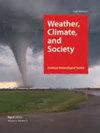Drivers of Household Risk Perceptions and Adjustment Intentions to Tornado Hazards in Oklahoma
IF 1.9
4区 地球科学
Q3 ENVIRONMENTAL STUDIES
引用次数: 0
Abstract
Tornadoes are responsible for considerable property damage and loss of life across the state of Oklahoma. While several studies have explored drivers of tornado adjustment behaviors, their results are not consistent in terms of their significance and direction. To address this shortcoming in the literature, we surveyed households using a disproportionate stratified sampling procedure from counties in Oklahoma that frequently experience tornado threats to explore drivers of adjustments. We used Structural Equation Modeling (SEM) to explore relationships among variables highlighted in the Protection Motivation Theory (PMT) and related literature that affect adjustment intentions and risk perceptions. Overall, we found the factors highlighted in the PMT are effective at explaining households’ intentions of adopting adjustment behaviors associated with tornado hazards. Threat appraisals, however, were less important than coping appraisals in explaining tornado hazard adjustment intentions. In further analysis, we grouped adjustments as 1) basic (e.g., flashlight, food and water supply) and 2) complex (e.g., insurance, storm shelter), and found that while coping appraisals are significant drivers of both adjustment categories, the effect of threat appraisals is only significant for complex adjustment intentions. We also found that emotional responses to hazards are major drivers of threat appraisals, stronger than perceived knowledge and hazard salience. Moreover, we found that demographic characteristics affect both adjustment intentions and threat appraisals. The additions to the PMT and categorization of adjustment activities improve our understanding of the PMT in different contexts. Such insights provide scholars and emergency managers with strategies for risk communication efforts.俄克拉荷马州家庭风险感知的驱动因素和对龙卷风危害的调整意图
龙卷风在俄克拉荷马州造成了巨大的财产损失和生命损失。虽然几项研究探讨了龙卷风调整行为的驱动因素,但其结果在意义和方向上并不一致。为了解决文献中的这一缺陷,我们对俄克拉荷马州经常遭受龙卷风威胁的县的家庭进行了不成比例的分层抽样调查,以探索调整的驱动因素。我们使用结构方程建模(SEM)来探索保护动机理论(PMT)和相关文献中强调的影响调整意图和风险感知的变量之间的关系。总的来说,我们发现PMT中强调的因素能够有效地解释家庭采取与龙卷风危害相关的调整行为的意图。然而,在解释龙卷风灾害调整意图方面,威胁评估不如应对评估重要。在进一步的分析中,我们将调整分为1)基本(如手电筒、食物和水供应)和2)复杂(如保险、风暴避难所),并发现虽然应对评估是这两类调整的重要驱动因素,但威胁评估的影响仅对复杂的调整意图具有重要意义。我们还发现,对危险的情绪反应是威胁评估的主要驱动因素,比感知的知识和危险显著性更强。此外,我们发现人口统计特征影响调整意图和威胁评估。PMT的增加和调整活动的分类提高了我们对不同背景下PMT的理解。这些见解为学者和应急管理人员提供了风险沟通工作的策略。
本文章由计算机程序翻译,如有差异,请以英文原文为准。
求助全文
约1分钟内获得全文
求助全文
来源期刊

Weather Climate and Society
METEOROLOGY & ATMOSPHERIC SCIENCES-
CiteScore
3.40
自引率
13.60%
发文量
95
审稿时长
>12 weeks
期刊介绍:
Weather, Climate, and Society (WCAS) publishes research that encompasses economics, policy analysis, political science, history, and institutional, social, and behavioral scholarship relating to weather and climate, including climate change. Contributions must include original social science research, evidence-based analysis, and relevance to the interactions of weather and climate with society.
 求助内容:
求助内容: 应助结果提醒方式:
应助结果提醒方式:


